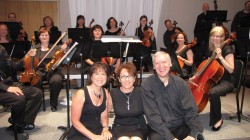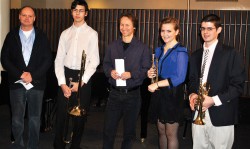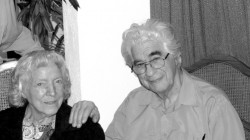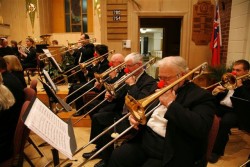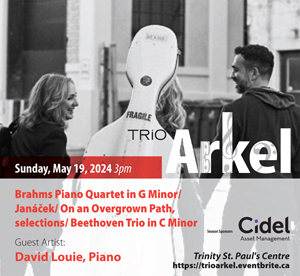Have Shell Will Travel
As i sit down to put pen to paper, or fingers to keyboard, the days are getting shorter and fall is almost on the horizon. There could be a temptation to do a bit of crystal ball gazing about what musical treats may be looming on the fall horizon. On the other hand, there are still several more weeks left before fall officially arrives, so let’s stay in the present for community music in the summer. For the most part, community orchestras take the summer off while for most community bands, public performance activity increases during the summer.
Having resisted the strong temptation to look at what may be on the fall horizon, I decided to get retrospective. How has the role of community bands evolved over the past century, and, in particular, how have their activities changed since I first produced sounds on an instrument out in public? Let’s look at performance venues, band activities, band membership, dress, influences of technology and repertoire.
Although concerts were a part of our activities when I first started in the band world, parades and tattoos were a much bigger part. During the summer months our band participated in many small town tattoos, but rarely mounted a stage for a concert. Local tattoos are almost a thing of the past, except for major ones such those in Quebec City and Halifax. With a few notable exceptions, most community bands today would decline any invitations to parade. They are “concert bands,” and many members would consider parading to be demeaning. So! Where do they perform their summer concerts? As for band membership, that has changed dramatically. My first band was a “boys’ band” as were most junior bands. As a rule, girls didn’t play in bands, but ours was an exception. We had two girls; it did help a bit that their father was the bandmaster.
A century ago most towns in this country had a town bandstand, most often in the style of a gazebo open on all sides. At some point some clever architect decided that it would be possible to focus the music and direct the sounds towards the audience. Eureka! The bandshell was born! When? I could find no literature on when or where the first bandshell was built. The earliest that I could find in this part of the world was opened in Cobourg in 1934. The most prominent bandshell in Canada, the great Art Deco structure at the Canadian National Exhibition, opened in 1936. It featured daily performances by the band of Knellar Hall, The Royal Military School of Music. With the exception of the years during WWII, daily band concerts on the shell were highlights of the CNE. During the 1950s and into the 1960s there were four concerts a day on the shell. Two of these were by featured bands from around the world and two each day were by local bands. That ended sometime in the 1960s. In the words of a CNE official, the role of the bandshell shifted to “pop culture.” This year, instead of four band concerts a day, there are only two scheduled for the entire period of the CNE. These, by a Canadian Forces Band, are for the opening ceremonies and on Warriors Day. Personally, this summer I performed at two shells and attended a concert at a third. The first of these was an afternoon performance in the town of Markham’s new portable, inflatable bandshell. Later that same day I travelled to one of the best known shells in Ontario, The Orillia Aqua Theatre.
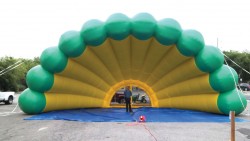 The Markham event warrants special attention. The brainchild of Markham Band members Peter Ottensmeyer and John Webster, the “Sunday Afternoon Band Series,” referred to as “Concerts, Cakes and Coffee,” encourages people to listen to the concert and then stroll through the older Markham Village to visit the shops, galleries and restaurants. Full concert programs available at the shell include discount coupons and a map showing all participating merchants. The bright yellow and green inflatable shell was funded through an Ontario Trillium grant. From a performer’s vantage point, it was not possible to evaluate its acoustic properties but people in the audience spoke very favourably of the new shell.
The Markham event warrants special attention. The brainchild of Markham Band members Peter Ottensmeyer and John Webster, the “Sunday Afternoon Band Series,” referred to as “Concerts, Cakes and Coffee,” encourages people to listen to the concert and then stroll through the older Markham Village to visit the shops, galleries and restaurants. Full concert programs available at the shell include discount coupons and a map showing all participating merchants. The bright yellow and green inflatable shell was funded through an Ontario Trillium grant. From a performer’s vantage point, it was not possible to evaluate its acoustic properties but people in the audience spoke very favourably of the new shell.
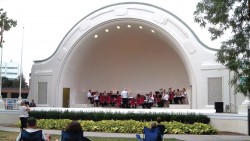 Changing technology has transformed many aspects of the activities of a modern community band. Who could have imagined an inflatable bandshell when the Cobourg bandshell was erected? Now many bands not only have websites, they post recordings of their current repertoire so that members may practice at home by playing along with the recordings. Helpful perhaps, but how does that influence their sight reading skills? Alternatively, a concert that I played a week ago was recorded and is available for me as an MP3 file to download to see how we sounded. Finally, on the technological front, the Uxbridge Community Concert Band is having a video documentary produced that will focus on the preparation of a new work by local composer Don Coakley, commissioned to celebrate the band’s 20th season.
Changing technology has transformed many aspects of the activities of a modern community band. Who could have imagined an inflatable bandshell when the Cobourg bandshell was erected? Now many bands not only have websites, they post recordings of their current repertoire so that members may practice at home by playing along with the recordings. Helpful perhaps, but how does that influence their sight reading skills? Alternatively, a concert that I played a week ago was recorded and is available for me as an MP3 file to download to see how we sounded. Finally, on the technological front, the Uxbridge Community Concert Band is having a video documentary produced that will focus on the preparation of a new work by local composer Don Coakley, commissioned to celebrate the band’s 20th season.
I had intended to take a look at the changes in how bands present themselves both in terms of dress and repertoire. However, the space limitations have caught up with me. That will be grist for the mill in a future edition.
Definition Department
This month’s lesser known musical term is Placebo Domingo:
a faux tenor. We invite submissions from readers.
Coming Events
Please see the listings section.
Jack MacQuarrie plays several brass instruments and has performed in many community ensembles. He can be contacted at bandstand@thewholenote.com.


